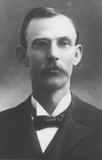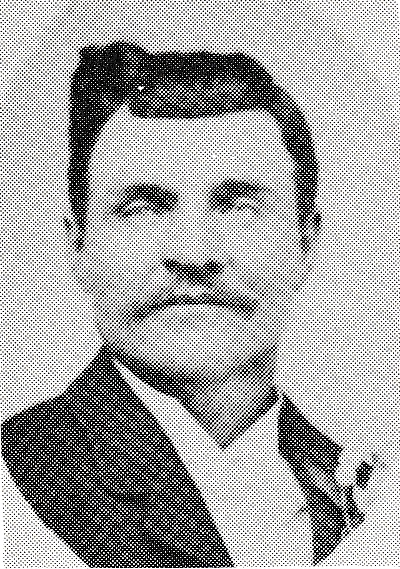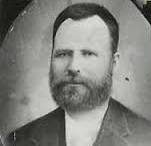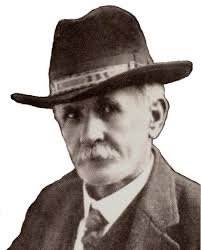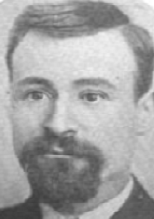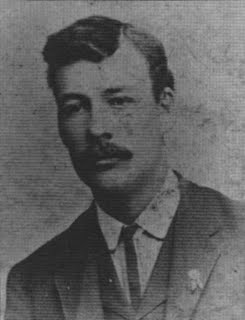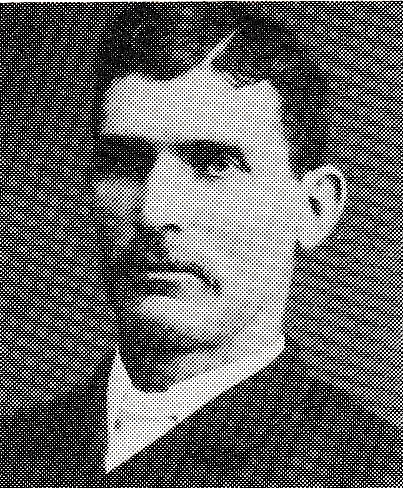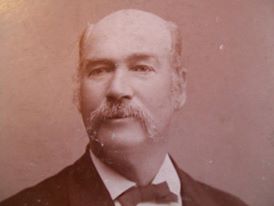Guy C. Wilson
1964-1942
The paternal ancestors of Guy C. Wilson are to be traced back in English and Scottish history. The first to come to North American colonies arrived in Boston around 1640. Guy C. Wilson’s grandfather, for whom he was named, was born in Chittendon County, Vermont, in 1801. It was this forbearer who, with his father and brothers, joined the Mormon Church and linked their lives with its dramatic early days.
Guy’s grandfather and namesake, with his wife Elizabeth and their family, left Nauvoo with others of the Saints in 1846. The rigors of the western journey proved too severe and Guy died on 17 September of that same year. Elizabeth and her 18-year old son Lycurgus, took charge of family affairs and pressed on to the Salt Lake Valley. There, three years later, when Lycurgus was 21, he married 14-year old Lois Ann Stevens. This occurred on November 29, 1849. The couple was called to help settle Sanpete Valley where they assisted in establishing what is now Fairview, Utah. And it was in Fairview, as the fourth of their eight children, that young Guy Carlton, bearing the name of his grandfather, was born April 19, 1864.
Guy Carlton Wilson’s eldest brother, Lycurgus Arnold, would, like Guy, later become with other members of his large polygamous family, residents of the Mormon Colonies in Mexico. Two of Guy’s sisters, Ellen Adelia and Mary Mehitable, became the polygamous wives of Philip Harrison Hurst, another Mexican colonist. Yet another sister married Andrew Peterson of Colonia Juarez. An both of Guy’s parents would later move to the colonies where they died and were buried.
In his youth, Guy received a strict Mormon upbringing. Unless given permission to do otherwise, he was expected to be home by dark, to report to his parents on every evening’s activity away from home, and to be faithful in his religious duties. Early on, he became attached to the habit of personal prayer, fully convinced that his prayers were always heard and answered. On one occasion as a boy, however, while searching for a lost cow, he thought he would employ the Lord in his errand. He knelt down and fervently pleaded that he might locate the animal after crossing the next little hill. Arising from his prayer, he was certain he would walk straight over the hill and see the cow immediately. Instead, it was nowhere in sight. Had God failed him? No. The boy’s mind reasoned out an explanation that served him well the rest of his life. “Had the Lord answered that prayer,” he said, “I would have kept Him busy all my life placing things or changing situations to suit my convenience, instead of learning the basic lesson that “the Lord helps those who help themselves.”
He displayed a zeal for learning and was always an avid reader. His studious manner earned him an unusual respect from his boyhood peers. The story is told that at one time he was with a group of friends, sitting around the stove in a Fairview store, listening to a group of laborers that had recently returned from observing mining operations at Bingham. The men told how they saw water lifted from one side of the canyon to a higher level at the other side by means of a long, specially constructed pipe. Young Guy protested that this was impossible because, without a pump, water could not be made to rise above its source. A heated argument followed, with men scoffing at the “know-it-all” kids.” The other boys insisted, however, that if Guy said it was impossible, so it was. It finally reached the point that both sides were willing to wager money on their opinions. One of the boys had recently been orphaned and had inherited a team of matching grays. He boldly stated, “If you say so, Guy, I’ll bet my team.” That ended the argument and those contending Guy Wilson was wrong, walked away.
Guy’s mother acted for years as both postmistress and telegraph operator in Fairview. As a boy, Guy learned morse code and often helped his mother with the transmission and receipt of messages. Inasmuch as these were the years when law enforcement authorities and Mormon polygamists were often engaged in a game of cat and mouse, young Guy, because of the central location and use of the telegraph of both sides, was often witness to the dramatic events of those days. Sometimes Church leaders or their emissaries would arrive in person, unannounced. One such occasion was long remembered by Guy. Porter Rockwell arrived in the middle of a winter’s night. After sending his telegraph message, he gladly accepted a plate of supper from the Wilson family. As he sat eating before the open fire, Guy’s curiosity got the better of him, and asked: “Brother Rockwell, how many men have you killed in your life?” Without a moment’s hesitation, Rockwell replied: ”Well, son, I reckon I never killed a single man that didn’t need killing.”
Recognizing their son’s zeal and special aptitude for learning, his parents fitted up a room with chairs and a blackboard in which Guy regularly met with friends with whom he studied and tutored. An older brother and sister had already gone on to normal school and were teaching the elementary grades in Pleasant Grove, Utah. In 1883, at the age of 19, Guy followed them and, in 1884, was himself employed as an elementary school teacher in the same community. Ever hungry for additional education, in the autumn of 185, at the age of 21, he left Pleasant Grove and enrolled in the Brigham Young Academy.
The year that marked his first experience as a formal school instructor was important for another reason. In September, 1884, he and Elvira Elizabeth Hartsborg were married in Salt Lake City by Daniel H. Wells. They saw that first year in Pleasant Grove through together and lived in Provo, Utah, while Guy attended the Brigham Young Academy in 1885. The next year Guy was called to serve in the Southern States Mission, with Elizabeth remaining in Fairview. Most of the time was spent in Kentucky and West Virginia. In later years he told him he told his children many tales of the primitive conditions he observed while living in the hill country of those two states.
After being released and returning to Fairview in 1888, Guy and Elizabeth moved to Salt Lake City where he attended normal school in the old Social Hall. In the fall of 1889, he accepted the position of principal of the district and returned to Fairview. For the next two years he oversaw Fairview’s schools and served as Counselor to Bishop James C. Peterson. Then, feeling the need for yet more schooling, he and Elizabeth moved to Provo where he could take additional course work in a variety of subjects. While there he distinguished himself as an outstanding player on the school’s baseball team. He also participated on the debating team and took part in dramatics. He was selected to be “Class Orator” for the Class of 1893.
Guy returned to Fairview as principal of the school district and as a Counselor in the Bishopric. His schooling and maturity, however, acted to point his interests in new and other directions. He began reading law and involving himself in local political affairs. Before long he was elected to the city council, then to the office of Justice of the Peace and, finally as prosecuting attorney. After adding to these achievements by being elected county commissioner, he resigned his post as school principal and successfully obtained the state Democratic Party’s nomination for the office of State Auditor. This was in 1895.
By this time Guy and Elizabeth had been married 11 years. They had prospered. They had an attractive home, a good team and buggy, and were respected citizens in their community. Since there was no bank in Fairview at the time, Guy kept his earnings in a box in his bedroom dresser. He was astonished at how rapidly his savings accumulated. His and Elizabeth’s needs were modest. Life seemed abundant in all regards, except for one: Guy “ached” for children, especially a son.
Then occurred an important coincidence of events. Anthony W. Ivins was set apart in 1895 to preside over the Mormon colonies in northern Mexico. Ivins, as a young man, had been one of those who accompanied Daniel W. Jones in his exploring and proselytizing journey into Mexico in the 1870’s. Like Guy, he had married and gone on a mission in the 1880’s. He then returned to St. George, and like Guy, had prospered and become active in politics. By the mid-1890’s he was being considered as the Democratic Party’s nominee for the state’s first race for governorship.
After visiting the colonies and surveying their needs, Ivins returned to Salt Lake City to confer with Church Authorities at the time of the April general conference in 1896. Among the most important of his recommendations to Church leaders was the imperative need for an improved school system in the colonies. Altogether too little had been done in this regard during the 10 years since the colonies had been established. Specifically, he asked that the Church subsidize a school system that would accommodate the colonists who were there and the hundreds of others who arrived from north of the border each year. Secondly, he wanted the best young educator that could be found anywhere in the Church to be called on a mission to preside over that system and bring it to a level of excellence that the toiling Saints in Mexico deserved. The authorities agreed to both requests. While the Church readily concurred to underwrite an important school system in Mexico, there was uncertainty as to who should be chosen to oversee it. President Ivins was told to consult Karl G. Maeser, the director the Brigham Young Academy in Provo. After describing the kind of person required, Dr. Maeser immediately told Ivins, “Guy C. Wilson is your man.” The result was an invitation to Guy to meet with President George Q. Cannon in his Salt Lake City office.
After being told what it was the authorities wished him to do, and given him time to consider it, Guy decided to accept and so informed President Cannon of his willingness. However, Guy had previously made preparations to spend the 1896-1897 academic year studying law at the University of Michigan and thus would be unable to go to the colonies until the autumn of 1897. President Cannon and Ivins both found this to be an acceptable delay. As it turned out, Guy did not go to Michigan but spent the year studying at Brigham Young University in Provo. When the agreed upon time arrived, he was given a formal missionary call, complete with the laying on of hands and papers, dated August 31, 1897, signed by the First Presidency of the Church, appointing Guy as head of the school system in the Mormon colonies in Mexico. Before leaving President Cannon’s office Guy was also told that his calling involved more than presiding over schools. He was expected to seek out and marry a suitable mate or mates in addition to his present wife. President Ivins, was informed, had been given authority to solemnize polygamous or “celestial marriages.” President Cannon assured Guy that the Lord did not want him to be forever childless. We cannot be entirely sure how Elizabeth responded to this second part of Guy’s calling. But she chose to stay in Utah when he left for Mexico in the autumn of 1897. Ant it has been said that she seemed “crushed and rebellious.”
Upon arriving in Colonia Juarez, Guy was introduced to the colonists and their leaders by Karl G. Maeser who made it a point to be present at the time. Guy, who was almost universally referred to thereafter as “Brother Wilson” or “Professor Wilson” took quarters in the home of Hanna S. Taylor. Student were invited to visit with him in the Taylor home and, before long, it became one of the favorite locations for young people in Colonia Juarez to meet and socialize.
Making friends with the students and listening to their problems was but a part of the responsibilities Professor Wilson had undertaken. Nevertheless, it was an important part of illustrated one of his best known strength: his capacity for relating to and communicating with others. It was not just that he was warm and magnetic in his personality. He also had the ability to quickly elucidate an issue and then, with uncanny skill, bring contentious personalities to a common understanding. Whether in the classroom or in church or civic gatherings, his remarkable gift for clear exposition and precipitating consensus marked him throughout his life.
A school building being constructed in Colonia Juarez and an addition was already being built when Professor Wilson assumed his responsibilities in the autumn of 1897. He immediately set about reorganizing tutorial “reader system” used by his predecessor Dennison E. Harris, into a ladder of eight separate grades. He added an additional teacher and saw 15 students graduate from the eighth grade in the spring of 1898. More importantly, after making a tour of the colonies and examining their schooling efforts, he concluded that a program for teacher training must be implemented so that local talent could be used to enrich the educational experience of young people in every colony. The result was the creation of a normal training center in the Juarez school. In addition to this, each year he added a new grade level of instruction so that, by 1901, six students were graduated and certified to teach in the elementary schools of the Stake.
In the summer of 1898 he went north to Salt Lake City where he reported to the First Presidency on his progress in turning the colony schools into an integrated system of graded, quality instruction. Church leaders expressed their approval. Then President Cannon asked how he was coming in connection with the rest of what he had been urged to do. Professor Wilson’s reply was, “I’m waiting for her grow up.” “Good,” said President Cannon, “Then, make it two.”
After his visit to Salt Lake City, Professor Wilson took his wife Elzabeth and spent the next three months attending summer school at the University of Chicago. When finished he left Elizabeth in Fairview again and returned to the colonies. He brought with him, as anew members of the faculty, Miss Ella Larson who had specialized in teaching training and dramatics and was a graduate of the Cook County Schools in Chicago and Miss Pearl Thurber, whose training was in music and elementary school and education. This same school year also saw the completion of new, larger school buildings. There were now five large, well equipped classrooms, a principal’s office and a library, topped with an attractive belfry.
Everyone was astonished to see how quickly the new building was filled with a growing student body. The faculty rapidly expanded to ten teachers. A movement was soon afoot to erect yet another larger structure. At a crowded town meeting called to discuss the problem, President Ivins donated five acres of his land for the project and pledges were made by other citizens totaling $12,000. When matching Church and Stake funds were made available, a beginning on the academy building was possible. Ground was broken on December 12, 1903, and the new structure opened its doors for use in September 1905. By 1908, four-year diplomas were being given in high school and normal school, and three-year certificates in domestic science and domestic art. Students came from all the colonies, many of them living during the school year with families in Colonia Juarez. As the school grew, three other buildings were added to the school’s physical plant. With the Academy providing high school education for students from all the colonies, some of whom were trained to return and oversee elementary instruction in their own communicates, the Juarez Stake Academy had become the mother institution for the entire system.
One of the things that is most surprising in the work of the school during these early years was the breadth of its curriculum. Courses were taught in physics, mathematics, music, bookkeeping, English literature, history, elocution, woodwork, agriculture, Spanish and, for prospective teachers, education philosophy and child psychology. There were athletic programs that fielded lively teams for both boys and girls. Student performance of dramas, musicals and operas provided enjoyment for the entire community. A tasteful but entertaining school paper was published. In 1903, largely to the work of Charles E. McClellan, a museum was begun. A brass band, complete with uniforms, a string orchestra, and special choirs were trained. In all of this one sees the broad educational outlook of Guy C. Wilson. The quality of work in the schools along with the rising level of culture in the Mormon communities, owed an immense debt to his initiative and vision.
During these years, Elizabeth sometimes spent Christmas vacations or other brief periods with her husband in the colonies. Professor Wilson, always anxious to obtain more schooling, had taken her with him while attending summer school at Columbia University in New York City in 1899. But there seemed to be no indication that tshe was willing to permanently move to Mexico and make a home there. This reluctance, combined with the childlessness of the marriage and the urgings of President George Q. Cannon, led Professor Wilson to enter “the principle.” We have noted his response to President Cannon in 1898 that he was waiting for a prospective bride “to grow up.” This suggests he may already have been thinking about young Agnes Melissa Stevens.
The family of David Alma Stevens had arrived in the colonies from New Mexico in 1890. Before moving to Mexico, David had been among the pioneers of the Hole-in-the Rock expedition of 1879 and 1880. Later he was involved in the La Plata shootings that were part of the New Mexico range wars. Though seriously wounded, David had survived and eventually relocated in Colonia Dublan with his wife, Agnes Sariah, and their four children. The oldest of these was Agnes Melissa who had been born in Fruitland, New Mexico, on September 2, 1883. Melissa was 14 years old and in the 7th grade when Guy C. Wilson first arrived in 1897. She was among his students for the next five years and was asked in 1901, even before completing her normal training and receiving her diploma, to teach the 3rd grade in Colonia Juarez. In the spring of 1902, being 18 years of age, and after a discreet courtship, Melissa was married to Guy C. Wilson as his second living wife. The ceremony was performed in Professor Wilson’s upstairs office in the old Academy building by President Anthony W. Ivins.
It will re recalled that President Cannon had at one time suggested to Professor Wilson, regarding the taking of additional wives, that he “make it two.” The year following his marriage to Melissa Stevens, on 13 May 1903, President Ivins sealed his own daughter, Anna Lowrie Ivins, to Professor Wilson. A year older than Melissa, Anna had come to the colonies with her rather when he was appointed President of the Stake in 1895. She had also been one of Professor Wilson’s students. She and Melissa had been especially close friends during the years previous to their marriages. In the years they spent as sister wives to Guy C. Wilson their love for each other only deepened. If Elizabeth withdrew somewhat in her relationship with her husband, the harmony and affection that existed between Melissa and Anna, including among the happiest examples of Mormon polygamy had produced.
The years that followed were in many ways the most rewarding of Guy C. Wilson’s life. Children began to arrive eventually numbering 14 between the two families. Along with the warmth of his domestic circumstances, his days were brightened by the presence in the colonies of his mother and father, two sisters and a brother, as well as the parents of his young wives. His talents were being used not only in connection with the administration of the school system, but as a Counselor to his father-in-law, Anthony W. Ivins, in the Stake Presidency. Finally, he was seeing the results of his labor at the Academy. Not only had the enrollment grown, but the quality of programs being offered was on a par with the best available at those grade levels anywhere in the United States. By 1912, for Guy C. Wilson, prospects for the future never seemed better.
The Mexican Revolution of 1910 swept over the colonies. Although no Mormons lost their lives at the hands of soldiers, there was considerable annoyance with pilfering. With the demand that colonists give up their guns, Church Authorities feared there would be no way to adequately defend themselves and that injuries would certainly follow. The result was the well-known Exodus of late July 1912. Both Melissa and Anna, with their children, were sent by train to El Paso for safety. Eventually Melissa and her children went to a ranch belonging to her rather, David Alma Stevens, just south of the border in Zaragosa, near the Rio Grande River. Anna was sent to live with her parents in Salt Lake City. With both families taken care of, Professor Wilson was given a year’s sabbatical leave by the Church and decided to spend it in post-graduate study with John Dewey, Edward Thorndike and others at Columbia University. His service at the Juarez Stake Academy was at an end and a new phase of life had begun.
Upon return from New York City in 1913, Professor Wilson established and oversaw the first seminary program in the Mormon Church. This was done at Granite High School in Salt Lake City. This was pioneering of a different kind again, and the fruits of his planting are known to every LDS family in North America today. In 1915 he became President of the LDS University. This was a four-year high school and business college. During his 10 years in that position, buildings were added and in 1920, the curriculum was enlarged to embrace two years of college work. Also, with B. Cecil Gates, he founded the McCune School of Music.
In 1926 he was succeeded by Feramorz Y. Fox and accepted an appointment as head of all the Church’s schools and seminaries. He continued at this until 1930 when he became Dean of the Divison of Religious Education at Brigham Young University. In addition to writing Church educational manuals, and sitting on numerous boards and committees, Professor Wilson was able to give considerable time to the classroom —- always his greatest professional love. If there was a particular objective that characterized his work, it was the desire to harmonize secular and scientific knowledge with the teachings of the Church. He was in adapting theology to the problems of everyday life and his passion for clear and correct exposition was exceeded only by a personal interest in the lives of his students.
By the late 1930’s his health began to decline. He was able to continue teaching through the autumn quarter of 1941 when, at the closing meeting of one of his classes, he was reported to say:”I have taught my last class.” This must have been a most difficult moment. Although he had traveled a long road, he made enormous contributions to the educational systems of the Church in both Mexico and the United States, had trained in classrooms in the finest universities of the land, and had raised two wonderful families with two happy, supporting companions, he was first and last a teacher. It was there that he had used his first to enrich the lives of so many others.
When he died on January 27, 1942 it was entirely appropriate that his funeral was one of the first functions held in the new Joseph F. Smith Memorial building, constructed to house the Division of Religion over which he had presided. It was also appropriate that at his request, the song sung by a BYU quartet was, “The Teacher’s Work is Done.”
Elizabeth spent her declining years in Salt Lake City, surviving until September 27, 1951. Melissa moved to Provo in 1926 until after Guy’s death. She then relocated in California, living at the home of her son, Guy C. Wilson, Jr. She was with her daughter Elizabeth, in La Jolla, California, when she died on March 21, 1965. Anna continued to make her home in Salt Lake City and passed away on October 30, 1967. Their children have distinguished themselves in business, education, and other professions. More than his children, however, there are thousands whose heritage includes the magic of time in a schoolroom with Professor Guy C. Wilson. The high level of cultural activity and taste, as well as the unusual amount of achievement associated with those who trace their roots to the pre-Exodus period of the Mexican colonies, must be at least partly credited to the influence of this remarkable man.
B. Carmon Hardy
Stalwarts South of the Border Nelle Spilsbury Hatch, page 781

